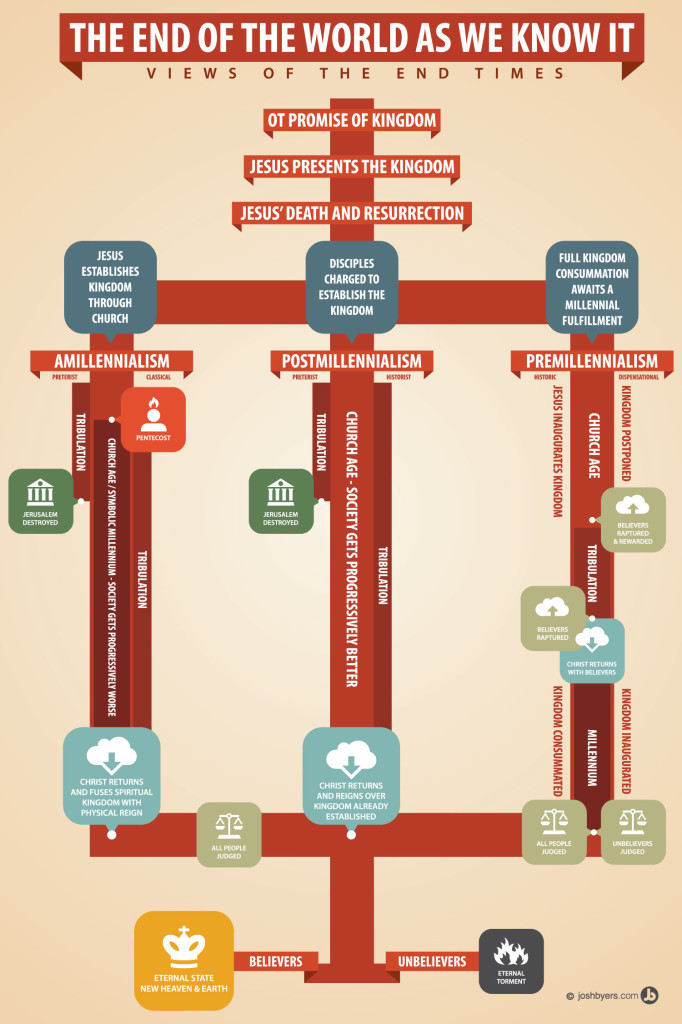For this weeks release of the Project 66 graphic I chose to go a bit out of order – or a lot out of order… There were many requests for this graphic depicting the differing views on the end times. The goal for this end times infographic was to summarize the major positions that Christianity has held over the years in regards to the timing of last things. The three major views are premillennialism, postmillennialism and amillennialism.
I’ve summarized the positions below the graphic. Hopefully that will help trying to decipher where you are at.
There are many differing views held within each of those individual camp so for simplicity only major points are illustrated. You can check the links to each for more information or search the terms and you’ll no doubt find hundreds and thousands of websites claiming point and counterpoint why they are right and the other position wrong.
An interesting concept that the graphic portrays is that each view agrees on the beginning and end. Every view believes that the kingdom was promised in the Old Testament, presented by Jesus and will culminate in the eternal state.
If you have suggestions for future graphics let me know in the comments.
A high resolution pdf is available for purchase.
Follow me on Twitter for the latest updates.

Premillennialism
Premillennialism is the belief that the Second Coming of Christ occurs before the millennium, which is a literal 1000 years.
Dispensational Premillennialists believe that believers will be caught up into heaven at the end of the church age before a time of great tribulation on the earth. They will then return with Christ to rule with Him for a literal 1000 years after which unbelievers are judged and the eternal kingdom is set up.
Historic Premillennialists believe that the rapture occurs at the end of the Tribulation and will immediately return with Christ to set up His kingdom.
Postmillennialism
Postmillennialismis the belief that the Second Coming of Christ occurs after the millennium.
Some that take this position believe the millennium is a literal 1000 years while others believe it is a figurative concept referring to the entire New Testament age.
Postmillennialism teaches that the forces of Satan will gradually be defeated by the expansion of the Kingdom of God throughout history up until the Second Coming of Christ.
The view that the tribulation has already taken place is the Preterist postion. The view that the entire church age is in tribulation is the historist view. These can also be applied to the amillennial postion.
Amillennialism
Amillennialism is the belief that there is not a literal 1000 year reign of Christ on the earth but that His Second Coming occurs at the end of history.
The millennium is purely spiritual in nature and at the end of the church age, Christ will return in final judgment and establish a permanent physical reign.
In the classical view the tribulation and anti-christ are looked at as symbolic in the book of Revelation. Like Postmillennialism, the Preterist view believes that almost all end-times prophecy was fulfilled before the destruction of Jerusalem in 70 A.D.
36 Comments
Comments are closed.


I like this, but I must add as you put in the amillennialist group, that we believe in the rapture also at the end of time. Your info graphic makes it seem only pretrib people believe in it. Also I would like you split out from this how many times each group believes Jesus will return. I subscribed so I will look forward to seeing more of your work.
Hi Mike,
Thanks for your comment. It’s always a fine line between how much you include before it starts to get cluttered but I agree that it does look like only those with a PreMil view believe in an actual rapture.
Indeed both the Post-Mill, as the A-Mill, are somehwhat suspect on the literal “Rapture”, based upon their general spiritual hermeneutic. The Historic Pre-Mill allows for both the spiritual and the literal hermeneutic.
[…] Endtimes Infographic This is very well done. Click on the graphic to enlarge. […]
I’ve never heard any Amillenial person talk about a rapture. It would seem highly odd to me if you put “Rapture” in the Amillenial timeline. What Amillenial people do you know of who believe in a rapture?
Many… for an accessible, articulate advocate, check out Kim Riddlebarger either online or in A Case for Amillennialism. Or Anthony Hoekema in The Bible and the Future.
The confusion comes about because of how use of the term “Rapture” has changed. Nowadays, it is synonymous with the “Secret Rapture” theory (think Dispensationalism & “Left Behind”). From Wikipedia:The term “Rapture” is used in at least two senses. In the pretribulation view, a group of people will be left behind on earth after another group leaves “to meet the Lord in the air.” This is now the most common use of the term… The other, older use of the term “Rapture” is simply a synonym for the final resurrection generally, without a belief that a group of people is left behind on earth for an extended Tribulation period after events of 1 Thessalonians 4:17. This distinction is important as some Christians never refer to “the Rapture” in religious education, but may use the older and more general sense of the word “rapture” in referring to what happens during the final resurrection.
I think you’re right on Wayne. Pop Culture and media because of the Left Behind series has burned rapture into most people’s minds as synonymous with Pre-Trib, Pre-Mil.
There is no “secret rapture” in dispensationalism theology. What there is is a lot of uninformed and misinformed people. The “secret” relates to its mystery, not to the event.But I agree, the Left Behind novels (which some see as valid theological teaching, unfortunately) wasn’t very helpful to the entire rapture issue.
There is a sect in the branch of historic premill that doesn’t even include it.
Eliane,Couple of thots:
We tend to call it “secret rapture” because it is a stealth event. In the Disp. scheme “The Rapture” is a disappearing act whereby the saints vanish while world history continues on. Both Disp. and their critics have used the phrase “secret rapture” for the Disp view. If calling it secret is not what modern Disp. prefer it is at least a Stealth Rapture.
For Amils and Postmils (or even Historic Premils) the idea of a rapture is simply one facet of the Second Coming which in not a stealth event. The Second Coming is a massive cosmic event which brings history to an end. The Rapture in the Disp concept is simply a change address for earthly saints as the time and history continue to roll on.
Go check out R.C. Sprouls explanation of the rapture.
I have amillenial leanings and I believe in a “rapture”, but not the same type as a Pre-trib, Pre-Mil does. The ‘catching up’ is to usher in the return of the King.
Thanks Josh!
It would had been helpful to have included Scripture references, but I understand how difficult it is to make a chart of so many nuances. I think this graphic works well for a broad view of the major views.
My pleasure, glad you like it.
You’re right it would have been difficult to manage all the Scripture connected with everything and still have some room on the graphic!
Hello, I am not post-millenial by any means, but post-mills wouldn’t say “society gets progressively better”. They would say that Christ’s kingdom grows and increases by the power of his Spirit until all worship him. Things aren’t just “getting better” by themselves; God is conquering hearts by love.
Well in my studies I’ve found that the traditional post-mil position is that the church advances the kingdom until the world is mostly ruled under Christianity so in that way society gets “better.” Its really the main difference between post-mil and a-mil.
This is also where some post-mil advocates believe in a “golden age” where Christianity is the law of the land for 1000 years.
Again there are so many variations to each position its almost impossible to represent everything that is out there.
Nice work, Josh. I might suggest a tweak that I learned from OT Allis that had alluded me. There are really only two views with variations of Pre- and Postmillennialism. That is because the Amil view is Postmillennial; that is, it sees the return of Christ occurring after the Millennium.
Perhaps Dispensationalism is more deserving of its own category than is Amillennialism because it diverges so starkly from the tenants of the historic orthodox views (as well as the Scriptures themselves).
You probably meant the “tenets” of the historic orthodox views, and you probably meant to add “in my opinion”, since many would not accept that last sentence as incontrovertible truth.
Yes, thanks Nathan. In my haste, I failed to do what I’m constantly urging my children to do: use the correct verbiage. And you’re correct, it is my opinion, but one with tremendous strength. I came to reject the Dispensational viewpoint while attempting to defend it when those who I contended with continuously beat me about the head with Scripture.
“whom” … I know. :)
I love the graphics. From both a practical and artistic point of view it is simply fantastic!Since I am in the Historic Premillennial camp, I saw a little something of concern. (I apologize in advance if I am mistaken.) But the talk about the “church age” seems a little dispensational-ish to me. We have been and are in the “present evil age” and hoping for the “age to come.” I don’t recall in my studies ever referring to it as a “church age.”
From my understanding we are a continuation of the people of God and ingrafted. Dispensational views invoke a new dispensation they call the church age to suggest the idea of two different “people of God.”
To some of us, if this in-between time has a name, we might call it the “now and the not yet” since the Kingdom has been inaugurated but not yet consummated.
Maybe this is just semantics, but it seems a little off to me.
Thanks for trying to summarize the views in your infographic!
Hi Josh! I want to begin by saying how much I love your blog. It’s simple and elegant. I also enjoy your writing style and design work. Keep it up.
I also appreciate your infograph. I understand that there is only so much that can be put into these things, but personally, I think I would have made an effort to distinguish – in the graphic – between Historic Premill and Dispensational Premil. I know you made that distinction in your comments, but I think those two views are so far apart that indeed one of the few things they have in common is that they both hold to a future literal millennial period. The three main views your graph mostly represents would fall under the category of Covenantal, with Dispensational having it’s own distinct approach to End Times, and indeed, to the scriptures as a whole.
But great job, nonetheless.
Cheers.
(P.S. as for me, I’m a amill-guy :)
Hi Derek,
Thanks for the kind words!
I actually do distinguish between the two in the graphic. If you look close, I know its small :) under each main heading I represent two sub-views. Historical pre-mil is on the left and dispensational pre-mil is on the right.
[…] Cliquer ici pour voir les différents formats du poster eschatologique. […]
[…] Views on the end times (infographic) […]
[…] Here’s a handy infographic on views of the end times. […]
[…] to Josh Byers for creating this helpful […]
Interesting graphic, but my problem is that it seems to assume that the only viable Christian options include “eternal torment,” but that is simply not true.
[…] nine Bible-themed infographics for the personal project he calls “Project 66,” unveiled his end times infographic earlier than he had planned, due to high demand for an illustration of the differing views on […]
As a graphic designer and illustrator, I am blown away by your graphics and subject matter. Great job! You are using your gifts well! I just might have to use your infographics to wallpaper my prayer room. =) Thank you!
[…] nine Bible-themed infographics for the personal project he calls “Project 66,” unveiled his end times infographic earlier than he had planned, due to high demand for an illustration of the differing views on the […]
By your chart we would be considered dispensational premillenialists but I don’t know that it’s fair to call us dispensational, because dispensationalism is the belief that salvation is different during the different dispensations and we believe Salvation is the same from start to finish.
That’s actually a common misconception. Dispensationalists believe salvation is by faith alone through all of history.
The difference is how God manages his relationship with people. He interacts with humanity differently during each dispensation.
[…] You can download a Letter or Poster size version of the graphic for free, though Josh has made it possible to purchase the sources files, a hi-res PDF, or even a professional print. Check it out. […]
[…] goal for this end times infographic by Josh Byers was to summarize the major postions that Christianity has held over the years in […]
Josh,
One major omission from the infographic (and all subsequent discussion) seems to be any comment about God’s relationship with Israel. It may seem tangential if one only focuses on the NT, but there are major OT prophetic promises to Israel that need to be “spiritualized” in a Post-mil or A-mil position. A major difference between Pre-mil’s like myself and these other positions is that we believe God did not abandon his unconditional covenants with Abraham’s physical descendants in 70 AD.